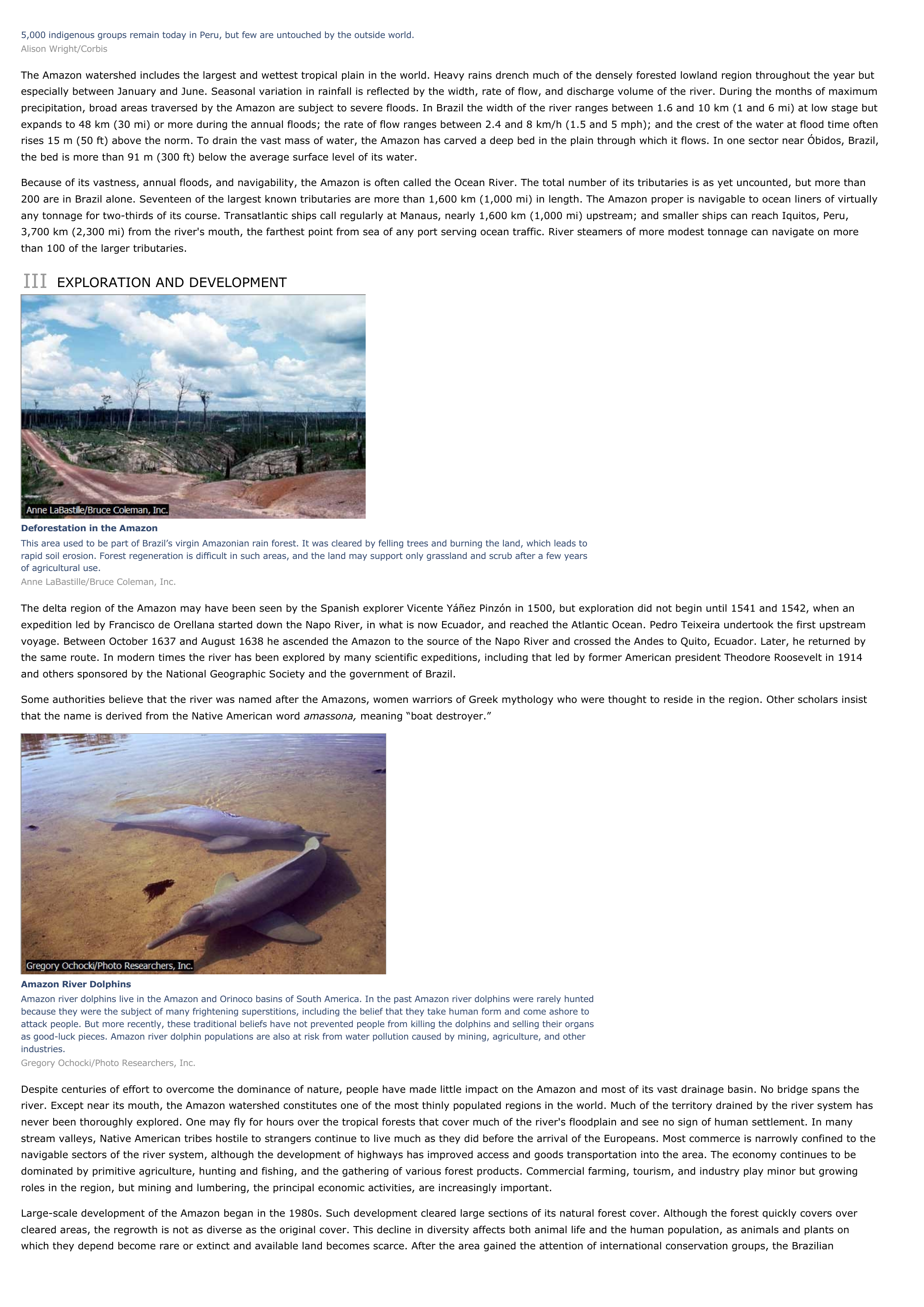Amazon (river) - geography.
Publié le 26/05/2013

Extrait du document
«
5,000 indigenous groups remain today in Peru, but few are untouched by the outside world.Alison Wright/Corbis
The Amazon watershed includes the largest and wettest tropical plain in the world.
Heavy rains drench much of the densely forested lowland region throughout the year butespecially between January and June.
Seasonal variation in rainfall is reflected by the width, rate of flow, and discharge volume of the river.
During the months of maximumprecipitation, broad areas traversed by the Amazon are subject to severe floods.
In Brazil the width of the river ranges between 1.6 and 10 km (1 and 6 mi) at low stage butexpands to 48 km (30 mi) or more during the annual floods; the rate of flow ranges between 2.4 and 8 km/h (1.5 and 5 mph); and the crest of the water at flood time oftenrises 15 m (50 ft) above the norm.
To drain the vast mass of water, the Amazon has carved a deep bed in the plain through which it flows.
In one sector near Óbidos, Brazil,the bed is more than 91 m (300 ft) below the average surface level of its water.
Because of its vastness, annual floods, and navigability, the Amazon is often called the Ocean River.
The total number of its tributaries is as yet uncounted, but more than200 are in Brazil alone.
Seventeen of the largest known tributaries are more than 1,600 km (1,000 mi) in length.
The Amazon proper is navigable to ocean liners of virtuallyany tonnage for two-thirds of its course.
Transatlantic ships call regularly at Manaus, nearly 1,600 km (1,000 mi) upstream; and smaller ships can reach Iquitos, Peru,3,700 km (2,300 mi) from the river's mouth, the farthest point from sea of any port serving ocean traffic.
River steamers of more modest tonnage can navigate on morethan 100 of the larger tributaries.
III EXPLORATION AND DEVELOPMENT
Deforestation in the AmazonThis area used to be part of Brazil’s virgin Amazonian rain forest.
It was cleared by felling trees and burning the land, which leads torapid soil erosion.
Forest regeneration is difficult in such areas, and the land may support only grassland and scrub after a few yearsof agricultural use.Anne LaBastille/Bruce Coleman, Inc.
The delta region of the Amazon may have been seen by the Spanish explorer Vicente Yáñez Pinzón in 1500, but exploration did not begin until 1541 and 1542, when anexpedition led by Francisco de Orellana started down the Napo River, in what is now Ecuador, and reached the Atlantic Ocean.
Pedro Teixeira undertook the first upstreamvoyage.
Between October 1637 and August 1638 he ascended the Amazon to the source of the Napo River and crossed the Andes to Quito, Ecuador.
Later, he returned bythe same route.
In modern times the river has been explored by many scientific expeditions, including that led by former American president Theodore Roosevelt in 1914and others sponsored by the National Geographic Society and the government of Brazil.
Some authorities believe that the river was named after the Amazons, women warriors of Greek mythology who were thought to reside in the region.
Other scholars insistthat the name is derived from the Native American word amassona, meaning “boat destroyer.”
Amazon River DolphinsAmazon river dolphins live in the Amazon and Orinoco basins of South America.
In the past Amazon river dolphins were rarely huntedbecause they were the subject of many frightening superstitions, including the belief that they take human form and come ashore toattack people.
But more recently, these traditional beliefs have not prevented people from killing the dolphins and selling their organsas good-luck pieces.
Amazon river dolphin populations are also at risk from water pollution caused by mining, agriculture, and otherindustries.Gregory Ochocki/Photo Researchers, Inc.
Despite centuries of effort to overcome the dominance of nature, people have made little impact on the Amazon and most of its vast drainage basin.
No bridge spans theriver.
Except near its mouth, the Amazon watershed constitutes one of the most thinly populated regions in the world.
Much of the territory drained by the river system hasnever been thoroughly explored.
One may fly for hours over the tropical forests that cover much of the river's floodplain and see no sign of human settlement.
In manystream valleys, Native American tribes hostile to strangers continue to live much as they did before the arrival of the Europeans.
Most commerce is narrowly confined to thenavigable sectors of the river system, although the development of highways has improved access and goods transportation into the area.
The economy continues to bedominated by primitive agriculture, hunting and fishing, and the gathering of various forest products.
Commercial farming, tourism, and industry play minor but growingroles in the region, but mining and lumbering, the principal economic activities, are increasingly important.
Large-scale development of the Amazon began in the 1980s.
Such development cleared large sections of its natural forest cover.
Although the forest quickly covers overcleared areas, the regrowth is not as diverse as the original cover.
This decline in diversity affects both animal life and the human population, as animals and plants onwhich they depend become rare or extinct and available land becomes scarce.
After the area gained the attention of international conservation groups, the Brazilian.
»
↓↓↓ APERÇU DU DOCUMENT ↓↓↓
Liens utiles
- Amazon (river) - Geography.
- St. Lawrence (river) - Geography. I INTRODUCTION St. Lawrence (river) (French Saint-Laurent), river
- Colorado (river, North America) - Geography.
- Congo (river) - Geography.
- Mississippi (river) - Geography.

































